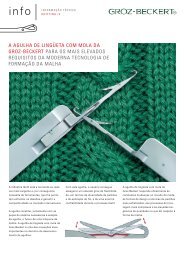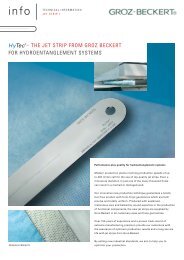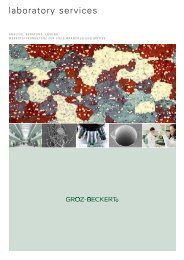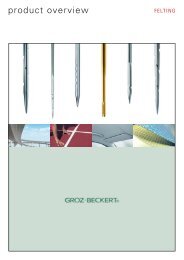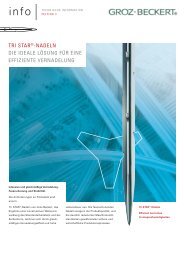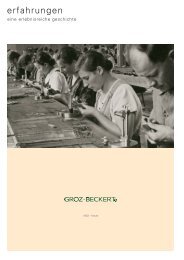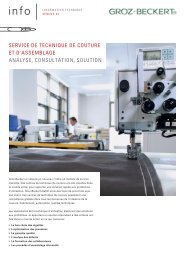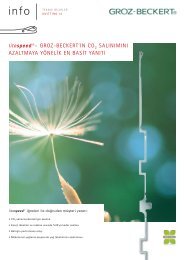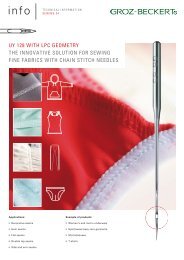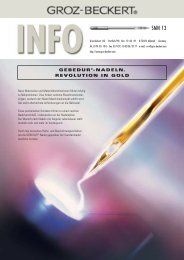English - Groz-Beckert
English - Groz-Beckert
English - Groz-Beckert
You also want an ePaper? Increase the reach of your titles
YUMPU automatically turns print PDFs into web optimized ePapers that Google loves.
experience<br />
an eventful history<br />
1852 - today
2 | INTRODUCTION<br />
Past experience determines the future – and, throughout its event -<br />
ful history since 1852, <strong>Groz</strong>-<strong>Beckert</strong> has experienced a great deal.<br />
During that time the company has developed with consistence and<br />
intelligence, overcoming periods of political as well as economic<br />
hardship by treating them as opportunities for new potential and<br />
new beginnings. The march of time never ends, and <strong>Groz</strong>-<strong>Beckert</strong><br />
continues to provide its own impetus on a sustainable basis.<br />
Find out all about the company's exciting history in this brochure.<br />
Discover how, over the past century and a half, <strong>Groz</strong>-<strong>Beckert</strong> has<br />
developed into an important partner for the entire textile industry.<br />
Look forward to numerous insights, prognoses, historic milestones<br />
and authentic tales from the past.<br />
>><br />
METICULOUS FROM<br />
THE VERY START:<br />
THEODOR GROZ'S<br />
NOTEBOOK (CA. 1883)<br />
THE BASIS:<br />
THE BUILDING ON BAHNHOFSTRASSE (CA. 1884)<br />
GROWTH:<br />
COMPANY HEADQUARTERS (CA. 1950)<br />
INNOVATIVE:<br />
TECHNOLOGY AND DEVELOPMENT CENTRE (2010)
BASED ON TRADITION:<br />
THE COATS OF ARMS OF<br />
THE GROZ AND BECKERT<br />
FAMILIES<br />
The depictions provided of our products are not to scale and are<br />
intended for illustrative purposes only. Consequently they make<br />
no claim to be an accurate representation of the original.<br />
® = Registered trademark of the <strong>Groz</strong>-<strong>Beckert</strong> company group.<br />
© = This publication is copyrighted. All rights reserved, in particular<br />
the right of duplication, distribution and translation. This<br />
publication or any parts thereof may not be reproduced or stored,<br />
processed, duplicated or distributed using electronic systems in<br />
any form or by any means whatsoever without the express written<br />
consent of <strong>Groz</strong>-<strong>Beckert</strong>.<br />
Introduction and contents 2 | 3<br />
In words<br />
Beginnings 4<br />
Development 6<br />
Continuation 8<br />
In brief<br />
1852 - 1969 14<br />
1970 - 1995 16<br />
1996 - 2002 18<br />
2003 - 2007 20<br />
2008 - 2010 22<br />
CONTENTS | 3<br />
>>
4 | BEGINNINGS<br />
The Swabian Alb, in the first half of the 19th century: a rough moun-<br />
tain plateau, sloping away at its south-eastern edge towards the upper<br />
reaches of the River Danube. This is the location of Ebingen, today<br />
known as Albstadt. The small Swabian town has only one thing to offer<br />
its inhabitants: a life of hardship. The people here are just only able to<br />
feed themselves from the fruits of their labour. Their primary source of<br />
income is hosiery knitting. It will be a long time before the incipient<br />
industrial revolution finally reaches Ebingen. One of those who will<br />
bring it here is Theodor <strong>Groz</strong>.<br />
>><br />
Theodor <strong>Groz</strong>, the son of Daniel <strong>Groz</strong>, a<br />
dispensing chemist, leaves his home town<br />
after his father’s early death and enters into<br />
an apprenticeship with a needle-master in<br />
Ludwigsburg. Then he travels further; his<br />
goal is Vienna. In this metropolis on the<br />
Danube he accumulates more experience<br />
in the art of needle manufacture. In 1852<br />
he returns to Ebingen and marries Rosina<br />
Rieber. He also opens a shop selling toys<br />
and fashion accessories, with its own needle<br />
workshop. His slogan, “Better needles”,<br />
is still valid today. At the same time Ernst<br />
<strong>Beckert</strong> is spending his childhood in the<br />
Saxon town of Eibenberg, near Chemnitz.<br />
Here, too, many people live primarily from<br />
hosiery knitting. Like his father before him,<br />
the 12-year-old Ernst <strong>Beckert</strong>'s father often<br />
has to work the hand wheel of the knitting<br />
loom. The young boy is not in the least<br />
interested in knitting, trains as a mechanic,<br />
and works in mining until he breaks both<br />
legs in an accident. He is confined to bed<br />
for months. More out of boredom than<br />
anything else, he occupies himself with<br />
his father’s needles and thinks about<br />
needle manufacture. He spends the last<br />
of his money on high-grade barbed wire,<br />
and tests out various production and<br />
hardening processes. At Christmas in<br />
1860, he makes his breakthrough. Thus,<br />
while Theodor <strong>Groz</strong> is celebrating his first<br />
successes in needle production and is<br />
already employing 25 people, Ernst <strong>Beckert</strong><br />
is also finding his way into the craft of<br />
needle-making. He grows increasingly<br />
ambitious and, in 1871, the year in which<br />
Bismarck declares the new German Reich,<br />
Ernst <strong>Beckert</strong> starts his own needle production<br />
in his home town of Eibenberg.<br />
From now on there are two needle factories<br />
in Germany, both heading in the same<br />
direction along a path that will ultimately<br />
bring them together.<br />
Non-stop series of inventions<br />
The road to worldwide success is a long<br />
one. The first requirement is economic<br />
survival. This is because needle production<br />
is a difficult trade, in which all the<br />
work is done by hand. At the same time it<br />
has to keep step with rapid innovation. In<br />
the early years Theodor <strong>Groz</strong> was only<br />
producing sharp-pointed iron needles, but<br />
soon a new material entered the market<br />
from France: steel. Good steel is expensive,<br />
however, and has to be hardened by<br />
means of a special process. Over the next<br />
few years it was the search for adequate<br />
material and a special hardening process<br />
that determined the working day and success<br />
at the end of it. In 1864, for instance,<br />
while Ernst <strong>Beckert</strong> in Saxony is perfecting<br />
his knowledge of needle-making, the<br />
Swabian Theodor <strong>Groz</strong> is threatened with<br />
the loss of his entire clientele. The reason:<br />
low-quality wire. Four hundred thousand<br />
circular warp loom needles have been<br />
produced but cannot be used – all part of<br />
the fate of a needle-maker. In the early<br />
1860s, the advance of steel is joined by<br />
that of a new type of needle – the latch
needle, invented by Matthew Townsend,<br />
an <strong>English</strong> textile engineer. The first person<br />
to produce these needles in Germany is<br />
Theodor <strong>Groz</strong>, starting in 1863. Eleven<br />
years later his son Daniel, together with<br />
his friend Daniel Beck, makes a decisive<br />
improvement to them. In future, the slot<br />
in which the latch is fastened is no longer<br />
stamped but machined. Daniel <strong>Groz</strong><br />
brought this idea with him from Saxony,<br />
where he had worked for two years for<br />
the biggest needle producers. He may<br />
even have made the acquaintance of an<br />
ingenious young entrepreneur named<br />
Ernst <strong>Beckert</strong>, who by then had opened<br />
his own factory and, in a few years' time,<br />
would be one of the biggest names in the<br />
business. On the Swabian Alb, these<br />
developments are accompanied by the<br />
transition from a workshop to a needle<br />
factory. Production is increased and everlarger<br />
hardening furnaces and more efficient<br />
steam engines are brought into use.<br />
One invention follows hard on the heels<br />
THE COMPANY'S OWN SPECIAL<br />
MACHINERY PRODUCTION AT<br />
THE BITZ FACTORY IN 1902<br />
of another: the pointed-needle press, for<br />
instance, or the “spoon” machine for producing<br />
latches, both of which were developed<br />
by a technical employee, Ferdinand<br />
Binder. By the mid-1880s needle production<br />
had already surpassed the million<br />
mark. Nowadays, however, far more than<br />
that quantity is produced in a single day.<br />
All in the family<br />
Economic growth is accompanied by<br />
expan sion of the premises. After 23 years<br />
the workshop in the street called Am<br />
Unteren Tor has outlived its usefulness.<br />
In 1875 Theodor <strong>Groz</strong> moves into new<br />
business premises in the Pfarrstrasse in<br />
Ebingen. In the same year Carl Theodor<br />
Beck starts to work for him in Bitz. The<br />
next few years bring various removals<br />
and extensions, and the head office of the<br />
firm does not reach its final home in the<br />
Wiesenstrasse until 1902. Today the street<br />
is named after the founder of the firm.<br />
Building work also begins in Chemnitz,<br />
BEGINNINGS | 5<br />
TOOL OF THE TIME:<br />
MANUAL SETTING DEVICE (CA. 1900)<br />
POINTED-NEEDLE PRESS >><br />
at Beckerstrasse 27-29. Within a quarter<br />
of a century Ernst <strong>Beckert</strong>'s business has<br />
grown to a considerable size. In 1895 a<br />
branch is opened in Stollberg, in the Erz<br />
Mountains, and over the following 10 years<br />
evolves into a complete factory. By 1898<br />
the company is already employing more<br />
than 200 people. The first Chemnitz factory<br />
is bursting at the seams. Building an extension<br />
on one side only brings short-term<br />
relief, however, and so an imposing new<br />
building is erected in the Metzer strasse<br />
in 1905. The move is no longer supervised<br />
by the founder himself, however, but by<br />
his son-in-law and successor Julius<br />
Seelmann-Eggebert. Ernst <strong>Beckert</strong> dies in<br />
Radebeul on October 4, 1909. Far away on<br />
the Swabian Alb, the generational change<br />
has taken place long since. Back in 1879<br />
Theodor <strong>Groz</strong> had made his two eldest<br />
sons, Theodor and Daniel, active partners<br />
in the firm, as reflected in the name of the<br />
company: Theodor <strong>Groz</strong> & Sons. It is not<br />
the older brother who succeeds the
6 | DEVELOPMENT<br />
father, however, for a sad reason: in April<br />
1892 both Theodor <strong>Groz</strong> Senior and Junior<br />
die within three days of one another. For<br />
a short time the inventive Daniel <strong>Groz</strong><br />
runs the company, but leaves it for health<br />
reasons in 1897. Management passes to<br />
his younger brother, Oskar, and to his<br />
brother-in-law Heinrich Cless who, however,<br />
leaves a few years later to set up his<br />
own business. Finally, in 1901, Adolf <strong>Groz</strong>,<br />
the youngest son of the founder, becomes<br />
an active partner. It is this generation of<br />
sons and sons-in-law, Oskar and Adolf<br />
<strong>Groz</strong> on the one side and Julius Seelmann-<br />
Eggebert on the other, which ultimately<br />
leads the two companies towards a merger.<br />
The first collaboration starts in 1918:<br />
the two companies have long since made<br />
names for themselves on the world market,<br />
and once World War I is over they<br />
decide to reactivate their international<br />
activities and establish a joint sales office<br />
in New York. A first step on the way to<br />
>><br />
joining forces? Certainly: They go on to<br />
prepare the second step, while the merg-<br />
er itself is ultimately carried out by their<br />
grand children's generation.<br />
Unravelling and rejoining<br />
The year 1923 brings hyperinflation – a loaf<br />
of bread costs several billion Marks. These<br />
consequences of the world war also leave<br />
traces on the needle industry. Everybody<br />
needs needles. Production cannot keep up<br />
with demand, and a lively but illusory<br />
econ omy develops. New needle factories<br />
appear. But then the economy collapses,<br />
money loses its value, and prices fall.<br />
Renowned needle factories con sider a<br />
merg er in 1924 in order to ensure their<br />
sur vival; the nine leading ones in Saxony,<br />
headed by Ernst <strong>Beckert</strong>, and the Swabian<br />
firm of Theodor <strong>Groz</strong> & Sons negotiate<br />
with one another. However, the economy<br />
now starts improving again and these<br />
negotiations peter out. Nevertheless the<br />
interest is there, the contacts have been<br />
made, and the idea continues to mature<br />
silently. Four years later merger plans<br />
col lapse again, this time because opinions<br />
differ about automatic production methods –<br />
in which the Swabians are a step ahead<br />
of the Saxons. However, Julius Seel mann-<br />
Eggebert is the only one of the Saxon<br />
manufacturers to recognize and respect<br />
this fact. From then on it is only the two<br />
biggest needle manufacturers, Theodor<br />
<strong>Groz</strong> & Sons and Ernst <strong>Beckert</strong>, who consider<br />
a merger. Many years are still to<br />
pass before one can come about, however.<br />
In 1937, the day finally comes: the new<br />
firm takes the name of 'Theodor <strong>Groz</strong> und<br />
Söhne & Ernst <strong>Beckert</strong> Nadel fabriken<br />
Commandit-Gesellschaft Ebingen und<br />
Chemnitz' – which, being rather long, is<br />
usually shortened to <strong>Groz</strong>-<strong>Beckert</strong>. It is<br />
managed by Hans and Walther <strong>Groz</strong>, the<br />
sons of Alfred <strong>Groz</strong>, and by Fritz Seelmann-<br />
Eggebert who took over from his father<br />
NEEDLE PATTERN BOOK CA. 1930<br />
WORKERS CA. 1935
Julius. The company represents two-thirds<br />
of the entire German knitting needle indus-<br />
try, which puts it in an excellent posi tion<br />
against competition. But then comes the<br />
war, and destruction.<br />
Heavy setbacks<br />
Chemnitz is heavily bombed in the night<br />
of 5th March 1945, and one of the buildings<br />
to be hit is the <strong>Beckert</strong> factory. Part of<br />
it is burned down, another part collapses.<br />
The finished-goods warehouse and all<br />
the needles and sinkers are destroyed.<br />
Everything is lost, even the company’s<br />
official rubber stamp. Nevertheless, most<br />
of the machines have only suffered minor<br />
damage and will soon be ready for use<br />
again. Friedrich Ernst <strong>Beckert</strong>, the son of<br />
the founder, and Dora Steude, a granddaughter,<br />
lose their lives. Fritz Seelmann-<br />
Eggebert is hit by a heavy air-raid shelter<br />
door and suffers bruises on his back.<br />
The <strong>Groz</strong> works in Ebingen and Bitz come<br />
off relatively lightly, Bitz remaining completely<br />
unscathed. However, on 17th April<br />
1945 low-flying aircraft open fire on the<br />
nearby Ebingen railroad station and set<br />
an ammu nition train on fire. The explosions<br />
continue all day, shattering doors<br />
and win dows. The roofs are damaged. The<br />
devastation is enormous, but the basic<br />
structure is unharmed. Then comes the<br />
fate ful moment – the end of the Third<br />
Reich, the start of the post-war era. The<br />
Allies demand reparations and start dismantling<br />
German industrial plants. <strong>Groz</strong>-<br />
<strong>Beckert</strong> is also affected. Everything that is<br />
left in the Chemnitz factory is dismantled<br />
and taken away to Russia. Fritz Seelmann-<br />
Eggebert is arrested and spends four<br />
years in Russian custody. More than 500<br />
machines are dismantled in Ebingen as<br />
well, and transported to France. But then<br />
something amazing occurs: the dismantling<br />
work is stopped. It is not possible to<br />
make proper use of the machines at their<br />
DEVELOPMENT | 7<br />
HUGE CHALLENGES:<br />
AFTER THE EXPLOSION OF<br />
THE AMMUNITION TRAIN IN<br />
EBINGEN ON 19.04.1945<br />
new destinations. At the same time there<br />
is a huge demand for needles in France.<br />
It is thus the French knitwear industry, of<br />
all things, which urges that <strong>Groz</strong>-<strong>Beckert</strong><br />
should be retained.<br />
>><br />
Social network<br />
What about the employees? How have<br />
they survived the war? What does restarting<br />
operations mean to them? Many have<br />
not yet returned from the war. Many are<br />
helping with the work of clearing up. And<br />
while the first customers come to<br />
Ebingen and enquire about needles, people<br />
have one major problem – hunger. The<br />
manage ment solves the problem by selling<br />
needles for food, which they distribute,<br />
because people who work also need<br />
to eat. This ingenious plan leads on to<br />
greater things; a works canteen is set up,<br />
and is a sign to the employees of social<br />
commitment. It is not the first in the company’s<br />
history; a works health fund had
8 | CONTINUATION<br />
EXEMPLARY:<br />
THE WORKS HEALTH FUND, DATING BACK TO 1888<br />
>><br />
been set up as long ago as 1888, a pre cursor<br />
of the works health funds now found<br />
in many big firms. Later, in 1929, it was<br />
joined by a pension and welfare fund.<br />
However, a year after the end of the war<br />
the French military government puts an<br />
end to these social security elements and<br />
the works health fund does not re-open<br />
until 1949, at the unanimous request of<br />
the workforce and in the face of opposition<br />
from representatives of a purely state-run<br />
social insurance plan. That is not all. The<br />
construction of several hundred workers’<br />
apartments helps to relieve the urgent<br />
housing shortage. Older employees are<br />
given the facility of relaxing once every<br />
two years in the company leisure centre<br />
in the Black Forest in addition to the<br />
annual holiday to which they are entitled.<br />
The company thus sets new standards in<br />
showing a sense of responsibility towards<br />
its employees by providing benefits far<br />
beyond the usual level.<br />
Successful connections<br />
Production starts up again. Under the<br />
pressure of circumstances, with materials,<br />
machines, and workers all in short supply,<br />
new technical designs and ever more<br />
highly automated production methods<br />
become established. International business<br />
contacts are also taken up again. People<br />
abroad remember the reliable <strong>Groz</strong>-<strong>Beckert</strong><br />
needles, and they need them. Urgently.<br />
Even before the war the company had<br />
been the world leader in the field of knitting<br />
and warp-knitting machine needles.<br />
Now, in a world divided into two power<br />
blocks, nothing is possible without the<br />
top-quality needles from the Swabian Alb.<br />
The Saxon needle factories are now stateowned<br />
enterprises and their output is all<br />
going to Russia. Although the needle<br />
industries in the Western countries have<br />
gained ground during the war years, their<br />
quality has still not caught up with that of<br />
<strong>Groz</strong>-<strong>Beckert</strong>. So the old contacts can be<br />
taken up again quickly. The testimonials of<br />
friendship are deeply moving; one customer<br />
from Crete reports that his father<br />
had wept with joy over the first consignment<br />
of needles, and had kissed each<br />
indi vidual box. Anyone who realizes that a<br />
textile manufacturer who has all the yarn,<br />
machinery, and workers that he needs but<br />
is condemned to idleness if he has no<br />
needles will understand this reaction. By<br />
1948 <strong>Groz</strong>-<strong>Beckert</strong> is already delivering to<br />
39 different countries, and exports account<br />
for 63 percent of the total output. In 1950<br />
as much is produced on the Swabian Alb<br />
as both factories together had been producing<br />
before the war, and twice as much<br />
in 1952. At this point in time the company<br />
employs 2,150 people – a figure that is set<br />
to grow constantly over the coming years.<br />
Far greater effect<br />
The company has been international right<br />
from its earliest days, and was already<br />
doing its first business in the USA back in<br />
the early 1860s. Regular overseas busi-
ness has been running since about 1880,<br />
although it has been interrupted many<br />
times, mainly by wars. But now, from 1952<br />
onwards, more and more production and<br />
affiliated sales companies are founded in<br />
Germany and abroad. For instance, in 1960<br />
<strong>Groz</strong>-<strong>Beckert</strong> starts to open up the growing<br />
Asian market by working out of the<br />
Indian city of Chandigarh. This is followed<br />
in 1969 by <strong>Groz</strong>-<strong>Beckert</strong> Portuguesa Lda,<br />
near Porto, and 10 years later anoth er<br />
Portuguese factory, Euronadel, is acquired.<br />
MADE TO MEASURE:<br />
NEEDLE PRODUCTION IN ALBSTADT-EBINGEN, CA. 1950<br />
THE ORIGINAL:<br />
FIRST EDITION OF<br />
"DER NADLER" IN 1953<br />
As a result of the political re-opening of<br />
Eastern Europe, <strong>Groz</strong>-<strong>Beckert</strong> takes over<br />
the Czech needle factory of AKRA and in<br />
2001 renames it <strong>Groz</strong>-<strong>Beckert</strong> Czech s.r.o.<br />
<strong>Groz</strong>-<strong>Beckert</strong> also opens a factory in China<br />
in the mid-1990s: Yantex. All these are just<br />
examples of the way the company has<br />
developed in the last 50 years. This development<br />
has been accompanied by an<br />
expansion of its fields of business.<br />
Up to 1980 <strong>Groz</strong>-<strong>Beckert</strong> was only engaged<br />
in the field of needles for knitting and<br />
warp-knitting machines, but now the range<br />
has been expanded to include needles<br />
for sewing and shoe machines and also<br />
felting and structuring needles. Finally<br />
the acquisition of the “Eisbär” brand in<br />
1998 and the Swiss firm of Grob Horgen<br />
AG in 2000 brought tufting and weaving<br />
machine accessories into the range as<br />
well. <strong>Groz</strong>-<strong>Beckert</strong> is thus showing proof<br />
of its technical competence in everything<br />
that requires precision, beyond the limits<br />
of needle production.<br />
CONTINUATION | 9<br />
Technology and Development Centre (TEZ)<br />
Develop, research and improve. What<br />
made Theodor <strong>Groz</strong> and Ernst <strong>Beckert</strong> successful<br />
entrepreneurs – and ultimately<br />
brought the company international<br />
success – remains a timeless maxim. In<br />
accordance with it, the Technology and<br />
Development Centre (TEZ) was built at<br />
the company's headquarters in Albstadt.<br />
It was officially opened in July, 2010.<br />
The TEZ is a platform for research and<br />
development, for intensification of the<br />
system concept, for innovations and for<br />
synergies. Here, in close cooperation with<br />
machine builders, users and partners,<br />
<strong>Groz</strong>-<strong>Beckert</strong> is shaping the textile future.<br />
Five Technical Centres for the most diverse<br />
textile production methods form the central<br />
focus: they are the Technical Centre<br />
Knitting, the Technical Centre Weaving, the<br />
Technical Centre Felting, the Technical<br />
Centre Tufting and the Technical Centre<br />
Sewing. Machines and production lines<br />
are also integral components of these<br />
IMPRESSIVE AND SETTING NEW STANDARDS:<br />
THE TECHNOLOGY AND DEVELOPMENT CENTRE<br />
>>
10 | CONTINUATION<br />
Technical Centres: They enable application<br />
experiments, the production of short and<br />
special runs as a service to partners, and<br />
also the testing of <strong>Groz</strong>-<strong>Beckert</strong> products<br />
under real production conditions.<br />
Furthermore, training options are available<br />
to customers and employees for everything<br />
relating to the <strong>Groz</strong>-<strong>Beckert</strong> core<br />
competencies. The broad and varied product<br />
range is being constantly enhanced<br />
by the addition of systems solutions and<br />
services. Initial examples of systems<br />
solutions here include knitting heads for<br />
circular knitting machines, the Board<br />
Master System (BMS) – an efficient semiautomatic<br />
machine for needleboard<br />
handling – and the entirely new needleholder<br />
GEBESWITCH ®. Moreover, in the<br />
service sector and as a complement to its<br />
laboratory services <strong>Groz</strong>-<strong>Beckert</strong> offers the<br />
"Card Clothing“ service in the Nonwovens<br />
division, plus a sewing-machine-needle<br />
consulting service. Integration of further<br />
>><br />
LABORATORIES AND TECHNICAL CENTRES – THE MOST<br />
IMPORTANT COMPONENTS OF THE TEZ<br />
training and qualification also plays an<br />
important role at the TEZ. At its headquarters<br />
in Albstadt, <strong>Groz</strong>-<strong>Beckert</strong> employs a<br />
full-time staff of roughly 30 commercial<br />
and 145 technical apprentices. In addition<br />
to development offices and various recrea<br />
tion rooms and conference rooms,<br />
the TEZ also contains a generously-sized<br />
training workshop for this purpose.<br />
Furthermore, together with the University<br />
of Albstadt-Sigmaringen, <strong>Groz</strong>-<strong>Beckert</strong><br />
is offering the course "Textile Product<br />
Technology – Technical Textiles“, and has<br />
made rooms and facilities at the TEZ<br />
available for this. A further key component<br />
of the Technology and Development<br />
Centre is the <strong>Groz</strong>-<strong>Beckert</strong> Laboratory,<br />
offering lab services for the most diverse<br />
sectors, ranging from textile technology<br />
and mechanical engineering to the aerospace<br />
industry. Chemical and failure analyses<br />
are carried out, along with materials<br />
consulting and development. A particular<br />
highlight is the auditorium: Equipped with<br />
state-of-the-art multimedia technology<br />
and simultaneous interpreting booths, it<br />
can accommodate up to 275 people.<br />
A connection to the future<br />
The Technology and Development Centre<br />
is not the only milestone where construction<br />
projects are concerned. In April 2007<br />
a pedestrian bridge made from reinforced<br />
concrete in the Albstadt district of Laut -<br />
lingen had to be dismantled because of<br />
corrosion and the resulting safety problems.<br />
Textiles are rust-free, of course – and<br />
this was reason enough for <strong>Groz</strong>-<strong>Beckert</strong><br />
to propose a textile solution for the<br />
reconstruction of the bridge. The plan was<br />
to use a special textile reinforcement in<br />
place of the ferroconcrete, in order to<br />
enable longer service life by means of<br />
comparatively better material properties<br />
as well<br />
as a positive eco-balance. The town of
THE TEZ AUDITORIUM ACCOMODATES<br />
UP TO 275 PEOPLE<br />
Albstadt decided in favour of these plans,<br />
and in March 2008 the contract was signed<br />
for the construction project. <strong>Groz</strong>-<strong>Beckert</strong><br />
acted as general contractor and also participated<br />
in the costs. Building work began<br />
on the substructure and other sections<br />
in November 2009. Just one year later,<br />
<strong>Groz</strong>-<strong>Beckert</strong> was able to officially hand<br />
over a 100-metre-long bridge to the town<br />
of Albstadt. This project is a prime example<br />
of what textile production can do, and is<br />
also a calling-card for Albstadt and the<br />
CONTINUATION | 11<br />
TEXTILES AT ITS CORE:<br />
THE TEXTILE REINFORCED CONCRETE BRIDGE<br />
IN ALBSTADT-LAUTLINGEN IS ROUGHLY<br />
100 METRES LONG<br />
>><br />
entire region.<br />
Parallel to these milestones, the company<br />
also successfully acquired further subsidiaries<br />
and distribution channels worldwide.<br />
With far more than 6,000 employees<br />
and around 70,000 prototypes, <strong>Groz</strong>-<strong>Beckert</strong><br />
is active internationally in over 150 markets.<br />
That is diversity – diversity with a<br />
past and a future.
Meßstetten, 1902
Workers at the Meßstetten branch in 1902. However much work materials and techniques have<br />
changed until the present day, it is the company's employees that have always been crucial to its<br />
success. The commitment, expertise and precision of each individual greatly define the superior<br />
quality of the products.<br />
>>
14 | 1852 - 1969<br />
THEODOR GROZ,<br />
COMPANY LETTERHEAD<br />
>> 1852 | 1863 | 1871 | 1884 | 1888 1905 | 1918 | 1922 | 1927 | 1929<br />
The founders<br />
ERNST BECKERT,<br />
COMPANY LETTERHEAD<br />
WARP KNITTING NEEDLE SOLID STAMPED NEEDLE<br />
1852_Theodor <strong>Groz</strong> opens a toys and fashion<br />
accessories store and also a needle-making<br />
workshop in Ebingen.<br />
1871_Ernst <strong>Beckert</strong> establishes a needle factory<br />
in Eibenberg in the Erz Mountains.<br />
Innovation<br />
1852_Theodor <strong>Groz</strong> produces warp-knitting<br />
needles used in seamless production for the<br />
very first time.<br />
1863_The first latch needle comes from<br />
Ebingen.<br />
New head office<br />
1884_Theodor <strong>Groz</strong> & Söhne move into<br />
the factory building on Bahnhofstrasse<br />
in Ebingen.<br />
Social commitment<br />
1888_Foundation of a works health fund.<br />
New building<br />
1905_New headquarters of the Ernst<br />
<strong>Beckert</strong> Needle Factory in Metzerstrasse,<br />
Chemnitz.<br />
Internationality<br />
1918_First joint foreign sales office<br />
of the <strong>Groz</strong> and <strong>Beckert</strong> companies<br />
established in New York, USA.<br />
1927_Foundation of a distribution<br />
company in Paris, France.<br />
Innovation<br />
1922_Introduction of solid<br />
stamped needles.<br />
Social commitment<br />
1929_Foundation of a company pension<br />
fund at Theodor <strong>Groz</strong> & Söhne.
SALES OUTLET IN NEW YORK<br />
1937 | 1945 | 1952 | 1960 | 1965 | 1969<br />
New start<br />
COMPANY MERGER<br />
EMPLOYEES AT CHANDIGARH<br />
HOFA-SPEC HOSIERY KNITTING NEEDLE<br />
1937_Theodor <strong>Groz</strong> & Söhne and Ernst<br />
<strong>Beckert</strong> merge to form one company.<br />
1945_The Chemnitz factory is destroyed<br />
in the war, and the machines are dismantled<br />
and taken to Russia.<br />
1945_The dismantling process is stopped<br />
in Ebingen at the request of the French<br />
textile industry, and production is restarted.<br />
Innovation<br />
1952_<strong>Groz</strong>-<strong>Beckert</strong> presents the<br />
Hofa-Spec hosiery knitting needle.<br />
It is a mere 0.34 millimetres thick.<br />
Jubilee<br />
1952_<strong>Groz</strong>-<strong>Beckert</strong> celebrates its 100th<br />
anniversary. The company employs<br />
2,150 people. A partnership agreement<br />
is concluded between the owners and<br />
the employees.<br />
Internationality<br />
1960_Foundation of a <strong>Groz</strong>-<strong>Beckert</strong><br />
production plant in Chandigarh, India.<br />
1965_Distribution company in<br />
Barcelona, Spain.<br />
1969_Foundation of the production<br />
company <strong>Groz</strong>-<strong>Beckert</strong> Portuguesa Lda.<br />
in Valadares near Porto, Portugal.<br />
1852 - 1969 | 15<br />
PRODUCTION PLANT<br />
IN PORTO<br />
>>
16 | 1970 - 1995<br />
MEANDER NEEDLE<br />
LOW-PROFILE MEANDER SHAPE NEEDLE<br />
>> 1971 | 1978 | 1980 1983 | 1987 | 1989 | 1991 | 1992<br />
Innovation<br />
1971_Introduction of the "meander" needle.<br />
1978_Further development of the meander<br />
shape to create the low-profile needle.<br />
Internationality<br />
1980_Acquisition of the company<br />
Torrington Portuguesa near Lisbon,<br />
Portugal; name changed to Euronadel<br />
Industrias de Agulhas Lda.<br />
Range expansion<br />
1980_<strong>Groz</strong>-<strong>Beckert</strong> now produces and<br />
distributes sewing- and shoe-machine<br />
needles as well as felting and structuring<br />
needles.<br />
HIGH PERFORMANCE STEEL/PLASTIC<br />
COMPOSITE NEEDLE, SPRING LATCH NEEDLE<br />
AND TRANSFER FLAT-KNITTING NEEDLE<br />
Innovation<br />
1983_Patent granted on the high performance<br />
steel/plastic composite needle. It<br />
combines the advantages of the full-shank<br />
with those of the low-profile meander<br />
shape needle.<br />
1987_Introduction of the spring latch<br />
needle for modern flat knitting machines.<br />
1989_Presentation of the compound needle<br />
for flat knitting with a transfer device.<br />
1989_Market rollout of the rectangular<br />
blind-stitch needle.<br />
1991_Introduction of the special application<br />
needle SAN ® for jeans and fine knitwear.<br />
1992_Presentation of the transfer flatknitting<br />
needle with integrated selector.<br />
Internationality<br />
1987_Foundation of a distribution company<br />
in Leicester, England.<br />
1991_Further distribution companies<br />
founded in Milan, Italy and Osaka, Japan.
SPECIAL APPLICATION NEEDLES<br />
SAN ® 10 AND SAN ® 6 GEBEDUR ®<br />
1993 | 1994 | 1995<br />
Innovation<br />
1993_Market rollout of the titanium<br />
nitride-coated GEBEDUR ® sewing-machine<br />
needle.<br />
1993_ Introduction of the Tri STAR ®, a<br />
felting needle with concave triangular<br />
surfaces.<br />
1994_Introduction of the felting needle<br />
GEBEDUR ® I. It is especially suitable for<br />
needling man-made fibres.<br />
Internationality<br />
1993_<strong>Groz</strong>-<strong>Beckert</strong> acquires the Akra-<br />
Werke in Budweis, Lužice and Klobouky,<br />
known collectively from 2000 onwards<br />
as <strong>Groz</strong>-<strong>Beckert</strong> Czech s.r.o.<br />
1993_Acquisition of Exeltor in Bedford,<br />
Canada.<br />
1994_Foundation of the distribution<br />
subsidiary <strong>Groz</strong>-<strong>Beckert</strong> de México S.A. de<br />
C.V. in Naucalpan, Mexico.<br />
1995_Foundation of the production<br />
company Yantex (Yantai) Precision Textile<br />
Accessories Co. Ltd. in Yantai, China.<br />
1970 - 1995 | 17<br />
Tri STAR ® NEEDLE GEBEDUR ® FELTING NEEDLE<br />
>>
18 | 1996 - 2002<br />
SELECTOR<br />
COMPONENT<br />
>> 1996 | 1997 | 1998 | 1999<br />
Innovation<br />
CIRCULAR KNITTING<br />
NEEDLE – JUST ONE OF<br />
COUNTLESS PATENTS<br />
1996_Selector for electronically<br />
controlled knitting machines.<br />
1996_Fine-gauge fork needle with<br />
gauge 38 gg.<br />
1997_Introduction of the felting needle<br />
GEBEDUR ® II. It is used for needling<br />
natural fibres as well as insulation and<br />
fireproof materials.<br />
1998_Introduction of the Cross STAR ®<br />
felting needle for production of the most<br />
uniform fabric.<br />
GAUGE PARTS TUFTING<br />
Range expansion<br />
1998_Acquisition of the "Eisbär" trademark<br />
and the tufting needle business<br />
of Jos. Zimmermann, Aachen.<br />
1999_Acquisition of the Singer Factory<br />
in Würselen.<br />
Internationality<br />
1998_Foundation of distribution subsidiary<br />
Sinotech Asia Ltd., Hong Kong.<br />
Cross STAR ®
2000 | 2001 | 2002<br />
Range expansion<br />
2000_<strong>Groz</strong>-<strong>Beckert</strong> acquires the Swiss<br />
company GROB HORGEN AG and is now<br />
active in the weaving-machine accessories<br />
market segment.<br />
New building<br />
2000_<strong>Groz</strong>-<strong>Beckert</strong> expands its production<br />
facilities in Albstadt.<br />
HEADQUARTERS IN<br />
ALBSTADT, GERMANY<br />
DISTRIBUTION SUBSIDIARY,<br />
HONG KONG<br />
Internationality<br />
2001_Foundation of two further distribution<br />
subsidiaries in Seoul, South Korea<br />
and Singapore.<br />
Range expansion<br />
2001_<strong>Groz</strong>-<strong>Beckert</strong> acquires the company<br />
of SCHMEING, Raesfeld, Germany, thereby<br />
expanding its weaving-machine accessories<br />
segment.<br />
Innovation<br />
2001_Special application needle SAN ® 11<br />
for multidirectional automatic and difficult<br />
quilt-stitching applications.<br />
2002_ALforfix ® heald frame.<br />
2002_The company has 40 active patents<br />
in the knitting sector alone.<br />
Jubilee<br />
2002_<strong>Groz</strong>-<strong>Beckert</strong> celebrates its 150th<br />
anniversary.<br />
1996 - 2002 | 19<br />
>>
20 | 2003 - 2007<br />
litespeed ® HyTec ®<br />
>> 2003 | 2004 | 2005<br />
Range expansion<br />
2003_Further expansion in the sewingmachine-needle<br />
sector.<br />
2004_<strong>Groz</strong>-<strong>Beckert</strong> enters the system<br />
components sector<br />
GEBECON ® SYSTEM COMPONENTS<br />
JETSTRIP<br />
TRANSFER<br />
WING NEEDLE<br />
Innovation<br />
2003_The litespeed ® needle is presented<br />
at the ITMA in Birmingham.<br />
2003_The GEBECON ® needle is patented.<br />
2004_<strong>Groz</strong>-<strong>Beckert</strong> discontinues the first<br />
HyTec ® jetstrips for waterjet hydroentanglement<br />
systems and taps new markets.<br />
2004_New fine-gauge fork needle with<br />
gauge 43 gg.<br />
2005_Introduction of the transfer<br />
wing needle and the TWIN C Power ® heald<br />
frame.<br />
Internationality<br />
2004_Foundation of P.T. <strong>Groz</strong>-<strong>Beckert</strong><br />
Indonesia in Bandung, as a new distribution<br />
subsidiary.<br />
TWIN C Power ® HEALD FRAME
TWINTEC ® TWIN FLAT STEEL HEALD<br />
2006 | 2007<br />
Range expansion<br />
NEEDLEHOLDER<br />
GEBESWITCH ®<br />
2006_Takeover of SMC GmbH and<br />
expansion of the range with cylinders,<br />
dials and sinker rings for circular knitting<br />
machines.<br />
2007_Acquisition of the Bräcker company's<br />
heald eye business.<br />
Innovation<br />
2007_Numerous different products<br />
and systems are presented at the ITMA<br />
in Munich:<br />
- OPTILOOP ® coating for knitting-machine<br />
needles.<br />
- Innovative packaging solutions for<br />
sinkers in knitting cylinders.<br />
- Circular knitting head for gauge E66.<br />
- Segmented cylinders for circular<br />
knitting machines to reduce energy<br />
consumption.<br />
- Cylinder with cooling ducts for active<br />
cooling systems.<br />
- Needle Oil Test Kit – neutral oil consulting<br />
and analysis in the knitting sector.<br />
KNITTING HEAD FOR CIRCULAR<br />
KNITTING MACHINES<br />
- TWINtec ® twin flat steel healds, new<br />
leno healds and ALtop ® heald frame.<br />
- Shedding system for weaving.<br />
- Board Master System (BMS) for all-round<br />
effective needleboard handling.<br />
- Developments in all-steel sets for the<br />
production of nonwoven and velour.<br />
- New generation Level Cut Looper (LCL),<br />
Nickel-Free Finish (NFF) and Cut Pile<br />
Looper Tungsten Insert (CPL-TI) for<br />
tufting.<br />
- Needleholder GEBESWITCH ® for mediumheavy<br />
lockstitching machines.<br />
New building<br />
2006_Preparations begin for the<br />
Technology and Development Centre at<br />
the company headquarters in Albstadt.<br />
2003 - 2007 | 21<br />
THE PLANNING PHASE:<br />
THE TECHNOLOGY AND DEVELOPMENT CENTRE<br />
AS A 3D MODEL<br />
SHEDDING SYSTEM FOR<br />
WEAVING MACHINES<br />
>>
22 | 2008- 2010<br />
TEXTILE REINFORCED<br />
CONCRETE BRIDGE IN<br />
ALBSTADT-LAUTLINGEN<br />
PosiLeno ® FRAME<br />
>> 2008 | 2009 | 2010<br />
Range expansion<br />
2008_Acquisition of the mechanical<br />
engineering companies Oskar Fischer<br />
GmbH and Knotex GmbH & Co. KG in<br />
the weaving sector.<br />
Innovation<br />
2008_Conversion kit for rotary knitting<br />
machines from gauges E28 to E44.<br />
2008_Positively driven leno device<br />
PosiLeno ® for far higher processing speeds.<br />
2008_ALbasic ® heald frame for looper<br />
weaving machines.<br />
2008_LPC lockstitch (Loop Position<br />
Control).<br />
2010_LPC chainstitch (Loop Position<br />
Control)<br />
Internationality<br />
2008_The distribution subsidiary<br />
<strong>Groz</strong>-<strong>Beckert</strong> Taiwan Ltd. begins operations<br />
in Taipei.<br />
2008_Foundation of <strong>Groz</strong>-<strong>Beckert</strong> Vietnam<br />
in Ai Nghia, Vietnam.<br />
Social<br />
2008_Construction work for a pathbreaking<br />
textile concrete bridge in<br />
Albstadt is given the go-ahead – a project<br />
comprehensively accompanied and<br />
supported by <strong>Groz</strong>-<strong>Beckert</strong>.<br />
2009_Short-time work and qualification<br />
measures as a consequence of the global<br />
recession.<br />
2010_Completion of the textile reinforced<br />
concrete bridge in Albstadt-Lautlingen<br />
and handover to the town of Albstadt.<br />
2010_Awarded the KYOCERA<br />
Environment Prize in the former German<br />
Bundestag, Bonn.<br />
New building<br />
2008_Construction work commences<br />
on the Technology and Development<br />
Centre at the company headquarters in<br />
Albstadt, Germany.<br />
2010_Official opening of the Technology<br />
and Development Centre (TEZ).<br />
FREE FOR USE FROM 2010:<br />
THE TECHNOLOGY AND DEVELOPMENT CENTRE
KNITTING I WEAVING I FELTING I TUFTING I SEWING<br />
www.groz-beckert.com<br />
EN | 06.2011



